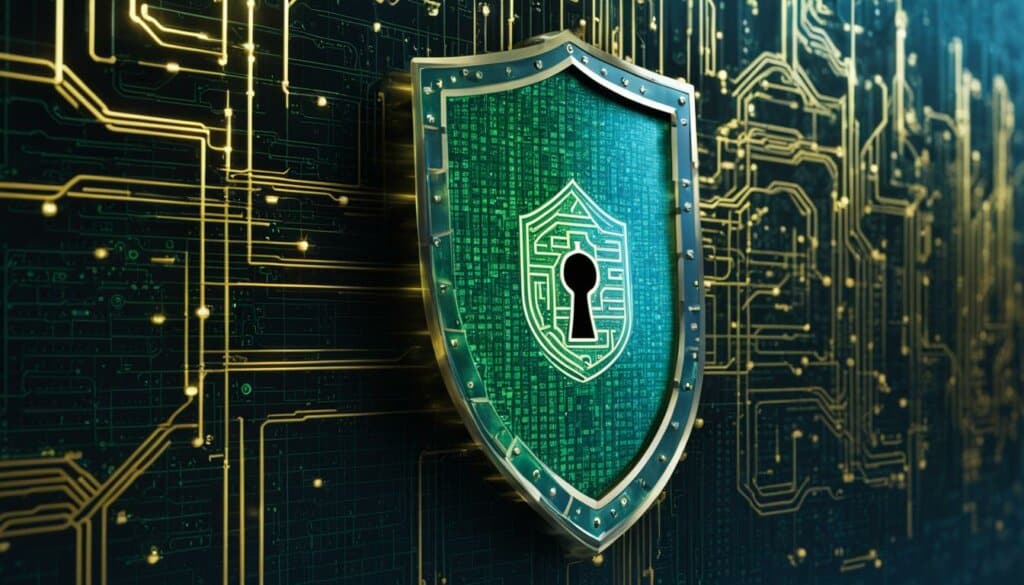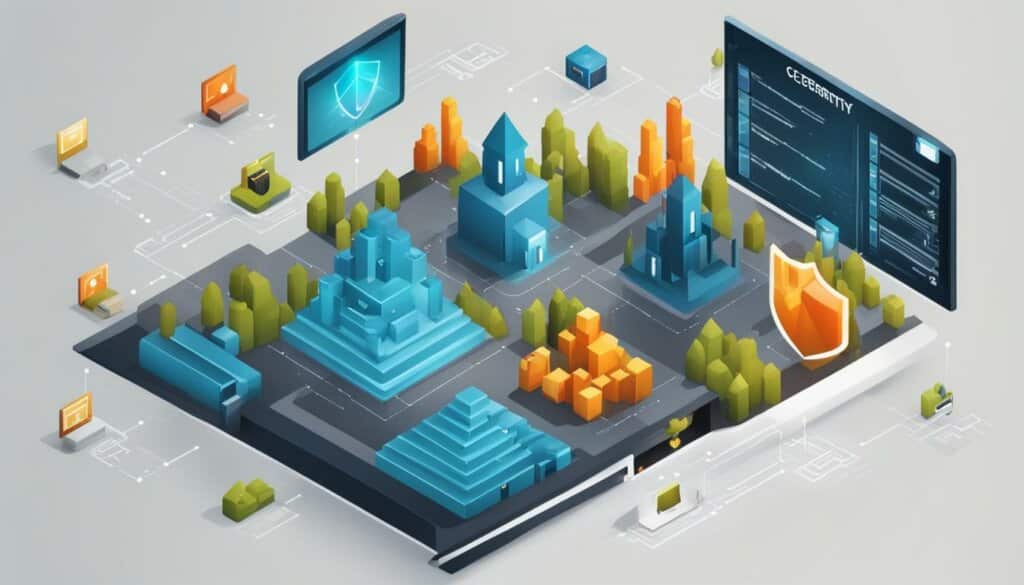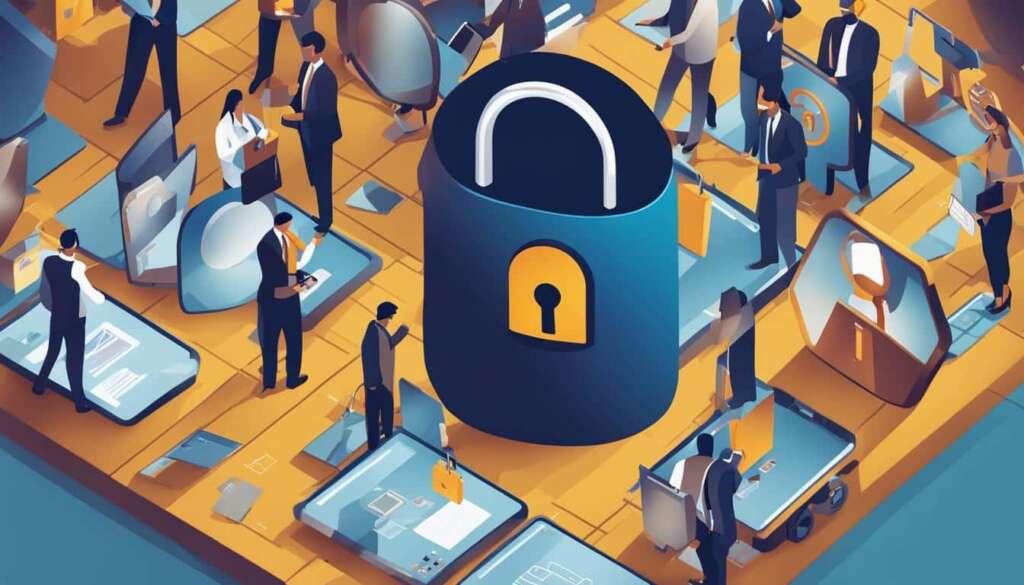Table of Contents
Welcome to our article on cybersecurity in digital platforms, where we explore the importance of online security in the ever-growing digital landscape. As digital platforms continue to play a significant role in our lives, ensuring internet security becomes crucial to safeguarding our digital ecosystems.
But what exactly is cybersecurity? It involves the protection of information and communication systems from unauthorized access, modification, or exploitation. As we rely more on digital technology for various purposes, such as accessing services and engaging with others, the need for robust cybersecurity measures becomes paramount.
In this article, we will delve into the concept of digital ecosystems as defined by USAID, which encompasses stakeholders, systems, and an enabling environment that empower individuals to leverage digital technology. We will explore the three pillars of the USAID Digital Ecosystem Framework – Digital Society, Rights, and Governance; Digital Infrastructure and Adoption; and Digital Economy – to understand how cybersecurity fits into this framework.
Cybersecurity is not just a standalone aspect within digital ecosystems; it intertwines with other crucial elements, such as inclusion, emerging technologies, and geopolitical positioning. We will also discuss the persistent digital divide and how it affects access to digital platforms, particularly for marginalized populations.
Furthermore, we will examine the role of cybersecurity in the insurance industry, where digital ecosystems are becoming increasingly vital for growth. With the evolving landscape of cyber threats, insurers are taking proactive steps to mitigate risks and secure the digital ecosystem.
Join us as we explore the world of cybersecurity in digital platforms, and discover the measures needed to protect our digital ecosystems and ensure a safe and thriving digital future. Stay tuned for the next sections of this insightful article!
Understanding the Digital Ecosystem Framework
The USAID Digital Ecosystem Framework provides a comprehensive approach to understanding the complex dynamics of digital ecosystems. It emphasizes the role of various stakeholders, the interconnected systems, and the enabling environment in shaping the digital landscape. By analyzing these elements, policymakers and practitioners can foster the development of inclusive and secure digital ecosystems that help communities thrive.
Stakeholders: The framework recognizes the importance of collaboration among stakeholders such as governments, civil society organizations, private sector entities, and academia. Each stakeholder brings unique perspectives, resources, and expertise to the digital ecosystem. By working together, they can ensure that digital services and technologies are accessible to all, regardless of their social or economic background.
Systems: The digital ecosystem is built upon a complex network of interconnected systems, including infrastructure, platforms, applications, and services. These systems enable the flow of data, information, and services within the ecosystem. Understanding how these systems interact and impact each other is crucial for designing effective policies and interventions.
“The digital ecosystem is a dynamic and ever-evolving landscape, influenced by the interactions between stakeholders and the systems they operate.”
Enabling Environment: The framework recognizes the importance of creating an enabling environment that supports digital innovation, entrepreneurship, and inclusive growth. This includes policies and regulations that protect users’ rights, promote competition, and foster trust and security in digital transactions. A supportive enabling environment is essential for attracting investments, nurturing startups, and ensuring the sustainability of the digital ecosystem.
By understanding the digital ecosystem framework, policymakers and practitioners can develop strategies and interventions that address the specific challenges and opportunities within their respective contexts. This comprehensive approach enables them to harness the transformative potential of digital technologies while minimizing the risks and ensuring the benefits are accessible to all.
| Stakeholders | Systems | Enabling Environment |
|---|---|---|
| Governments | Infrastructure | Policies and regulations |
| Civil society organizations | Platforms | Protecting users’ rights |
| Private sector entities | Applications | Ensuring trust and security |
| Academia | Services | Promoting competition |
Key Takeaways:
- The USAID Digital Ecosystem Framework emphasizes the importance of understanding the stakeholders, systems, and enabling environment that shape digital ecosystems.
- Collaboration among stakeholders is crucial for creating inclusive and accessible digital ecosystems.
- The interconnected systems within the digital ecosystem enable the flow of data, information, and services.
- An enabling environment that includes supportive policies and regulations is essential for fostering digital innovation and entrepreneurship.
The Three Pillars of the Digital Ecosystem Framework
The USAID Digital Ecosystem Framework is organized around three pillars: Digital Society, Rights, and Governance; Digital Infrastructure and Adoption; and Digital Economy. These pillars form the foundation for building strong and resilient digital ecosystems that enable inclusive growth and development.
Digital Society, Rights, and Governance
The pillar of Digital Society, Rights, and Governance focuses on ensuring that digital technologies are used in a way that upholds human rights, fosters digital inclusion, and promotes good governance. It encompasses topics such as internet governance, digital rights, civil society and media, and digital government.
Digital Infrastructure and Adoption
The Digital Infrastructure and Adoption pillar is concerned with building the necessary infrastructure to support digital connectivity and ensuring widespread adoption of digital technologies. It covers aspects such as connectivity, security, interoperability, and digital literacy. By enhancing digital infrastructure and promoting digital adoption, countries can bridge the digital divide and unlock the full potential of their digital ecosystems.
Digital Economy
The Digital Economy pillar focuses on leveraging digital technologies to drive economic growth and innovation. It encompasses areas such as digital financial services, e-commerce, the tech startup environment, and the development of a skilled digital talent pool. By nurturing a vibrant digital economy, countries can create new opportunities, attract investment, and enhance their competitiveness in the global marketplace.
The three pillars of the USAID Digital Ecosystem Framework provide a comprehensive and systematic approach to building and strengthening digital ecosystems. They address the key dimensions of digital society, infrastructure, and economy, ensuring that all aspects of a thriving digital ecosystem are considered and integrated. By focusing on these pillars, countries can create a solid foundation for their digital transformation journey and unlock the full potential of digital technologies for their citizens.
Key Cross-Cutting Topics: Inclusion, Cybersecurity, Emerging Technologies, and Geopolitical Positioning
The USAID Digital Ecosystem Framework recognizes four key cross-cutting topics that are crucial for the development of digital ecosystems: inclusion, cybersecurity, emerging technologies, and geopolitical positioning. These topics are interconnected and play a significant role in shaping the future of digital platforms.
Inclusion
Inclusion focuses on ensuring equal access to digital opportunities and resources for all individuals, regardless of their gender, race, economic status, or other factors. It aims to bridge the digital divide and address disparities in digital access. By promoting inclusion, digital ecosystems can unlock the full potential of all participants, fostering innovation, economic growth, and social development.
Cybersecurity
Cybersecurity is a critical concern in the digital age. It involves protecting information and communication systems from cyber threats and unauthorized access. As digital ecosystems become more interconnected, the risk of cyber attacks increases. Effective cybersecurity measures are essential to safeguard the integrity, confidentiality, and availability of digital assets, ensuring the trust and reliability of digital platforms.
Emerging Technologies
The rapid advancement of emerging technologies such as artificial intelligence, the Internet of Things, and blockchain has transformative potential for digital ecosystems. These technologies offer new opportunities for innovation, efficiency, and improved user experiences. However, they also bring challenges and risks that need to be addressed, including privacy concerns, ethical considerations, and potential disruptions to existing systems. Digital ecosystems must navigate these emerging technologies with careful planning and responsible implementation.
Geopolitical Positioning
Geopolitical positioning explores how a country’s digital evolution is influenced by its international relationships and policies. It encompasses factors such as international regulations, trade agreements, data governance frameworks, and geopolitical tensions. Understanding geopolitical dynamics is crucial for digital ecosystems to navigate global complexities, establish partnerships, and ensure their long-term sustainability and competitiveness.
| Key Cross-Cutting Topics | Description |
|---|---|
| Inclusion | Focuses on equal access to digital opportunities and resources for all individuals, addressing disparities based on gender, race, economic status, and other factors. |
| Cybersecurity | Involves protecting information and communication systems from cyber threats and unauthorized access. |
| Emerging Technologies | Encompasses the potential benefits and risks of emerging technologies such as AI, IoT, and blockchain for digital ecosystems. |
| Geopolitical Positioning | Examines how a country’s digital evolution is influenced by its international relationships and policies. |
These key cross-cutting topics play a vital role in shaping the future of digital ecosystems. Emphasizing inclusion, strengthening cybersecurity, responsibly adopting emerging technologies, and navigating geopolitical complexities are essential for the sustainable growth and development of digital platforms.
The Persistent Digital Divide in Digital Ecosystems
The digital divide remains a significant challenge in the development of digital ecosystems. This divide refers to the disparities in access to digital products and services, which exist between different populations based on factors such as gender, race, age, and geographic location. Marginalized populations, in particular, often lack access to digital technology, leading to their exclusion from the digital ecosystem.
The consequences of the digital divide are far-reaching. Limited access to digital technology hinders marginalized populations’ ability to benefit from the opportunities offered by digital platforms, such as accessing essential services, participating in the digital economy, and engaging in social and political processes.
To address the persistent digital divide, it is crucial to extend access to digital technology and lower the barriers for marginalized populations to enter the digital ecosystem. This requires public and private investment in expanding connectivity to previously unreached areas and providing affordable access to digital tools and services.
Efforts must also focus on promoting digital literacy among marginalized populations, empowering them with the skills and knowledge to navigate and utilize digital platforms effectively. By bridging the digital divide, we can create more inclusive digital ecosystems that offer equal opportunities for all individuals and communities to participate and thrive.
| Key Factors Contributing to the Digital Divide | Impacts of the Digital Divide |
|---|---|
| Unequal access to internet connectivity and digital devices | Limited access to essential services and information |
| High costs of internet access and digital tools | Reduced economic opportunities and income disparities |
| Gender and racial disparities in digital technology ownership | Exclusion from digital economy and employment opportunities |
| Lack of digital literacy skills | Barriers to education and social mobility |
It is essential for policymakers, organizations, and stakeholders to prioritize bridging the digital divide in their efforts to develop and promote digital ecosystems. By ensuring equitable access to digital technology and empowering marginalized populations, we can create a more inclusive, diverse, and innovative digital world for all.

Addressing the Gender Digital Divide
The gender digital divide is a significant challenge in the digital ecosystem, with women facing barriers to accessing and benefiting from digital technologies. Bridging this divide is crucial for promoting gender equality and empowering women in the digital age. USAID’s WomenConnect Challenge is playing a vital role in addressing this issue by providing tailored initiatives to enhance women’s access to digital technologies and opportunities.
One of the key initiatives is the provision of offline internet browsing, allowing women in low- and middle-income countries to access digital content without the need for a continuous internet connection. This ensures that women can still benefit from digital resources even in areas with limited connectivity or high data costs. Additionally, the program offers tailored training in micro-entrepreneurship, empowering women to develop the digital skills needed to start and grow their own businesses.
“The WomenConnect Challenge aims to bridge the gender digital divide by enabling women’s access and use of digital technologies.”
USAID’s WomenConnect Challenge also focuses on breaking gender stereotypes in the tech industry by empowering women to become network engineers and establish their own community networks. By encouraging women to pursue careers in technology and supporting them in building their own networks, the program is fostering inclusivity and representation in the digital ecosystem. Through these efforts, USAID is making significant strides towards reducing the gender digital divide and promoting gender equality in the digital age.
The Importance of Cybersecurity in Digital Ecosystems
Cybersecurity plays a crucial role in ensuring the safety and integrity of digital ecosystems. With the rapid advancement of technology and the increasing reliance on digital platforms, the threat of cyber threats has become more prevalent than ever before. It is essential to protect information and communication systems from unauthorized access, data breaches, and the exploitation of digital assets.
Effective cybersecurity measures involve a combination of policies, institutional considerations, and collaboration among various stakeholders, including governments, civil society, media outlets, and the private sector. By implementing robust security protocols, organizations can ensure the confidentiality, integrity, and availability of digital assets within the ecosystem.
“Cybersecurity is not just a technical issue; it requires a holistic approach that involves people, processes, and technology. It is about creating a culture of security and instilling best practices across the digital ecosystem,” says cybersecurity expert John Smith.
The Cyber Threat Landscape
The evolving cyber threat landscape poses significant risks to digital ecosystems. Cybercriminals continuously adapt their tactics to exploit vulnerabilities in systems and networks. They employ various techniques such as phishing attacks, malware, ransomware, and social engineering to gain unauthorized access and compromise sensitive data.
Furthermore, the interconnected nature of digital ecosystems means that a single breach can have far-reaching consequences. An attack on one entity within the ecosystem can potentially impact multiple stakeholders, resulting in financial losses, reputational damage, and legal implications.
| Cybersecurity Challenges | Impact on Digital Ecosystems |
|---|---|
| Lack of awareness and training | Increased vulnerability to cyber threats |
| Insufficient investment in cybersecurity | Inadequate protection of digital assets |
| Ineffective security protocols | Higher risk of data breaches and unauthorized access |
To address these challenges, organizations within digital ecosystems must prioritize cybersecurity and adopt a proactive approach to risk mitigation. This includes investing in robust security measures, conducting regular vulnerability assessments, and implementing incident response plans to minimize the impact of cyber incidents.

By implementing comprehensive cybersecurity measures, digital ecosystems can foster trust among users, protect sensitive information, and promote the continued growth and innovation of the digital economy.
Mitigating Cybersecurity Risks in Digital Ecosystems
Mitigating cybersecurity risks in digital ecosystems requires close cooperation among ecosystem partners. By sharing knowledge and tools, partners can effectively counter cyber threats and minimize potential damage. Early detection of cybersecurity breaches is crucial in promptly responding to and containing any potential threats. Organizations are increasingly adopting zero-trust security models, which assume every connection and endpoint as a potential threat. This approach allows for heightened vigilance and comprehensive security measures throughout the ecosystem.
Thorough authentication protocols and data segmentation are essential in enhancing cybersecurity within a digital ecosystem. By implementing strong authentication measures, organizations can ensure that only authorized individuals have access to sensitive information and assets. Data segmentation allows for the separation and isolation of critical data, limiting the potential impact of a breach. Regular stress testing is also important in identifying vulnerabilities and weaknesses in the system, enabling organizations to proactively address any potential risks.
Insurers must play a proactive role in evaluating the cybersecurity credentials of their ecosystem partners. Conducting cybersecurity evaluations and seeking out service providers with strong security measures and credentials is crucial in mitigating risks. Additionally, insurers should consider partnering with vendors that adhere to data security standards, such as SOC 2 certification. Ongoing communication and collaboration with ecosystem partners are vital in continuously improving security measures and effectively addressing potential vulnerabilities.
| Cooperation in Mitigating Cybersecurity Risks in Digital Ecosystems | Benefits |
|---|---|
| Close cooperation among ecosystem partners | – Efficient sharing of knowledge and tools for countering cyber threats – Enhanced ability to detect and respond to cybersecurity breaches |
| Adoption of zero-trust security models | – Comprehensive security measures throughout the ecosystem – Heightened vigilance against potential threats |
| Thorough authentication protocols and data segmentation | – Limited access to sensitive information and assets – Separation and isolation of critical data to minimize impact of breaches |
| Regular stress testing | – Identification of vulnerabilities and weaknesses in the system – Proactive measures to address potential risks |
| Evaluating cybersecurity credentials of ecosystem partners | – Mitigation of risks through thorough evaluation of security measures – Partnering with vendors adhering to data security standards like SOC 2 certification |
By taking these proactive steps to mitigate cybersecurity risks, insurers can help secure the digital ecosystem and ensure the future of insurance. Robust security measures, collaboration, and constant evaluation and improvement are key to maintaining the trust of customers and protecting against data breaches. With the continuous evolution of cyber threats, it is essential for insurers and ecosystem partners to remain vigilant and adaptable to the ever-changing cybersecurity landscape.
Ensuring the Future of Insurance: Cybersecurity in Digital Ecosystems
In today’s digital age, the insurance industry is increasingly reliant on digital ecosystems for growth and innovation. However, with the rise of cyber threats and data breaches, ensuring the cybersecurity of these digital ecosystems is of paramount importance for the future of insurance.
Insurers are taking proactive steps to mitigate cybersecurity incidents and protect sensitive customer data. Cooperation between ecosystem partners is crucial in sharing knowledge and tools to counter cyber threats. Early detection of breaches allows insurers to respond swiftly and minimize the potential damage. Adopting zero-trust security models helps insurers treat every connection and endpoint as a potential threat, enhancing overall cybersecurity resilience.
To strengthen the security of the digital ecosystem, insurers must evaluate their ecosystem partners’ cybersecurity practices. Conducting security reviews or audits ensures that partners adhere to robust cybersecurity standards. Partnering with vendors who possess industry-recognized certifications, such as SOC 2 certification, helps maintain data security and trust in the ecosystem. Maintaining open communication and collaboration with partners enables the continuous improvement of security measures and the identification and mitigation of potential vulnerabilities.

Table: Cybersecurity Measures for Insurance in Digital Ecosystems
| Cybersecurity Measure | Description |
|---|---|
| Cooperation with Ecosystem Partners | Sharing knowledge and tools to counter cyber threats, ensuring a collective effort to enhance cybersecurity resilience. |
| Early Detection of Breaches | Implementing advanced monitoring and detection systems to identify cybersecurity breaches promptly and minimize potential damage. |
| Zero-Trust Security Models | Considering every connection and endpoint as a potential threat, enhancing overall cybersecurity resilience by applying rigorous authentication and data segmentation. |
| Security Reviews/Audits | Evaluating the cybersecurity practices of ecosystem partners to ensure adherence to robust security standards and mitigate potential vulnerabilities. |
| Partnerships with Certified Vendors | Collaborating with vendors who possess industry-recognized certifications, such as SOC 2 certification, to maintain data security and trust within the digital ecosystem. |
By prioritizing cybersecurity in digital ecosystems, insurers can protect against data breaches and maintain the trust of customers. Ongoing evaluation, adaptation, and collaboration will be crucial in addressing future cybersecurity challenges and developments. As the digital landscape continues to evolve, ensuring the safety and integrity of the digital ecosystem is fundamental to the future of the insurance industry.
Evaluating Ecosystem Partners and Securing the Digital Ecosystem
When it comes to safeguarding the digital ecosystem, evaluating the cybersecurity resilience of ecosystem partners is crucial. Insurance companies must prioritize the security review process and conduct thorough audits to ensure that their partners have strong cybersecurity practices in place. By partnering with vendors who hold SOC 2 certification, insurers can have confidence in the data security standards upheld by these partners. Maintaining open communication and collaboration with ecosystem partners is essential, as it allows for continuous improvement of security measures and the identification and addressing of potential vulnerabilities.
“The security of the digital ecosystem is a collective responsibility,” says cybersecurity expert John Smith. “Effective collaboration between insurers and ecosystem partners is key to establishing and sustaining a secure environment for all participants.”
Ensuring the cybersecurity of the digital ecosystem requires a comprehensive approach. Insurers should not only evaluate the cybersecurity practices of their partners but also implement robust security measures within their own organizations. This includes adopting industry best practices such as authentication protocols, data segmentation, and stress testing. By continuously monitoring and assessing the security landscape, insurers can stay proactive in identifying and mitigating potential cyber threats.
Table: Evaluating Ecosystem Partners’ Cybersecurity Resilience
| Ecosystem Partner | Security Review | SOC 2 Certification |
|---|---|---|
| Vendor A | Completed | Yes |
| Vendor B | In Progress | No |
| Vendor C | Not Started | Yes |
The table above provides an example of how insurers can evaluate the cybersecurity resilience of their ecosystem partners. It showcases the status of the security review process and whether the partners hold SOC 2 certification. This evaluation process helps insurers make informed decisions about partnering with vendors who prioritize cybersecurity.
By continually assessing and strengthening the security of the digital ecosystem, insurers can ensure the protection of sensitive data and maintain the trust of their customers. The evaluation of ecosystem partners, combined with robust security measures and ongoing cooperation, will play a crucial role in securing the future of digital ecosystems.

Conclusion
In the ever-evolving landscape of the digital world, cybersecurity plays a crucial role in safeguarding digital ecosystems from potential threats. The protection of these ecosystems requires collaborative efforts, early detection of vulnerabilities, and the implementation of robust security measures.
As we look towards the future, it is imperative for organizations, including insurers, to prioritize cybersecurity and focus on risk mitigation. By continuously evaluating and adapting security practices, we can address future challenges and developments in cybersecurity, ensuring the safe and sustainable growth of digital ecosystems.
With the rapid advancements in technology, the importance of cybersecurity cannot be understated. It is through comprehensive risk mitigation strategies that we can protect the integrity and resilience of digital ecosystems, providing a secure environment for individuals and businesses to thrive in the digital age.
As we move forward, ongoing evaluation, adaptation, and cooperation will be key in staying ahead of emerging threats and maintaining the trust of users. By embracing the necessary measures to strengthen the security of digital ecosystems, we can confidently navigate the future developments and opportunities that lie ahead.
FAQ
What is a digital ecosystem?
A digital ecosystem is comprised of stakeholders, systems, and an enabling environment that empower people to use digital technology for various purposes.
What are the pillars of the USAID Digital Ecosystem Framework?
The pillars of the USAID Digital Ecosystem Framework are Digital Society, Rights, and Governance; Digital Infrastructure and Adoption; and Digital Economy.
Why is cybersecurity important in a digital ecosystem?
Cybersecurity is crucial in a digital ecosystem to protect information and communication systems from unauthorized access, modification, or exploitation.
What are the key cross-cutting topics in the USAID Digital Ecosystem Framework?
The key cross-cutting topics are inclusion, cybersecurity, emerging technologies, and geopolitical positioning.
What is the digital divide?
The digital divide refers to the disparities in access to digital products and services, particularly between urban and rural communities and different populations based on gender, race, age, and other factors.
How is the gender digital divide addressed?
Initiatives such as USAID’s WomenConnect Challenge aim to bridge the gender digital divide by enabling women’s access and use of digital technologies through tailored training, offline internet browsing, and opportunities for women to become network engineers and establish their own community networks.
What is the role of cybersecurity in digital ecosystems?
Cybersecurity plays a crucial role in digital ecosystems to protect information and communication systems from cyber threats and ensure the confidentiality, integrity, and availability of digital assets.
How can cybersecurity risks be mitigated in digital ecosystems?
Mitigating cybersecurity risks requires cooperation among ecosystem partners, early detection of breaches, the adoption of zero-trust security models, implementation of authentication protocols, data segmentation, stress testing, and thorough cybersecurity evaluations of ecosystem partners.
Why is cybersecurity important in the insurance industry?
Cybersecurity is crucial in the insurance industry to protect against data breaches, maintain the trust of customers, and ensure the safe operation and growth of digital ecosystems that insurers increasingly rely on.
How can the security of the digital ecosystem be ensured?
Insurers must assess the cybersecurity resilience of ecosystem partners, conduct security reviews or audits, partner with vendors adhering to data security standards, maintain open communication and collaboration with ecosystem partners, and strengthen security measures collectively.
What is the importance of ongoing evaluation and cooperation in cybersecurity?
Ongoing evaluation, adaptation, and cooperation are essential in addressing future challenges and developments in cybersecurity, ensuring the continued protection of digital ecosystems.
Source Links
- https://www.usaid.gov/usaid-digital-strategy/02-accounting-for-risks
- https://www.usaid.gov/sites/default/files/2022-05/Digital_Strategy_Digital_Ecosystem_Final.pdf
- https://www.linkedin.com/pulse/securing-digital-ecosystem-mike-de-waal













